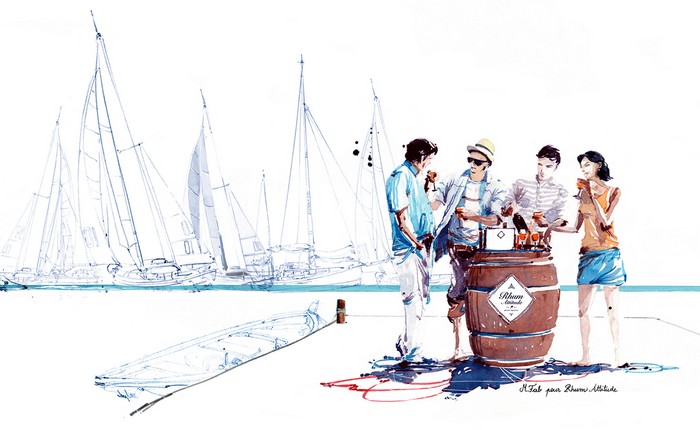
When you're new to this world, tasting a rum may seem like a complex ceremony, to be performed according to the rules of the art, otherwise you risk making a faux pas. However, it is a simple and friendly pleasure, without any snobbery, which you can enjoy to the fullest by following a few little tips.
First of all, know that the tasting notes that you can read on our site, or on various blogs, books and social networks, are simple indications that aim to situate the rum in a certain style and that transcribe the very personal impressions of the taster. Indeed, everyone connects their sensations to their own history, to their intimate library of aromas , memories and emotions, each one being linked to the other in a mesh that is personal to us all.
So, no need to feel self-conscious if you don't find the notes of Mexican jasmine or Kalamata olive oil that seem so obvious to the author of the tasting commentary. Similarly, your grandmother's plum tart will probably not taste the same as yours, but in any case, we will remember a gourmet and pastry idea of cooked fruit.
The tasting notes are also intended to give you an idea before buying, by getting an impression of the families of aromas that compose it and the general feeling that emerges from it. It can be interesting to compare these notes with yours during the tasting to open your mind to another register of aromas, but it is in no way a checklist to validate from A to Z.
Prepare your tasting
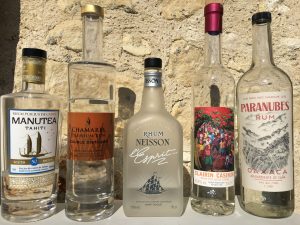
Most of the time, we taste one rum at a time, just for the pleasure of it. We don't necessarily have the desire or the time to embark on a big tasting, we simply want to find ourselves face to face with our rum, simply, without analysis. In this case, we can move directly to the next title.
But to understand rum and its subtleties , we often prefer to taste at least two rums side by side, so that the aromas and sensations appear clearly by contrast . Even people who believe themselves to be incapable of distinguishing the aromas of a rum quickly play along and easily spot these contrasts. The number of formulas is then almost infinite, but here are a few examples:
– The “ discovery ” tasting consists of preparing a series of rums with very different origins and characters. For example, we can offer a series of 6 rums: white agricultural rum, old agricultural rum , traditional Spanish molasses rum, traditional English molasses rum, and an “unclassifiable” rum from Japan, for example.
– The horizontal tasting is a comparison of rums from the same tradition and the same age, with for example a nice series of VSOP rums from Martinique .
– Vertical tasting consists of tasting the products of the same distillery, starting with the white, up to the oldest.
– We can also make selections by country of origin , by tradition, by style, and then by more technical things like the type of distillation or the type of barrel used for aging .
When it comes to the order of tasting , we often reason by intensity. The lightest rums will be tasted first, and the richest at the end.
When you first discover the rums you are going to taste and you don't know which one has the most body or which one is the most full-bodied, you tend to sort them by age , then by alcohol content . This method can have its flaws and it is probably better to find out about the method of production of the rums beforehand. For example, a very young Jamaican rum is much more aromatic than a very old rum from Panama.
If you are already a somewhat seasoned taster, there is probably a rum that you know well and that you like for its balance. You can use it as a reference and serve a glass near your selection in order to calibrate your nose and your palate .
It can be an absolute standard meter, or by style. For my part and to do this, I prefer traditional English rums like those of Foursquare or Appleton which are at the crossroads of several styles. If my tasting concerns Martinique, I choose a JM XO, if it concerns South America , I go for a Santa Teresa 1796, etc.
Rum tasting
Even if everyone tastes their rum as they wish of course, the choice of glass is still very important if we want to grasp all the complexity and subtlety of a tasting rum . We have devoted a short article on the choice of glass on this same site.
The standard dose for a glass of 40% rum is 3cl. However, if you want to taste several rums or if your selection contains rums with very high degrees, 2cl, 1cl, or even a few drops are enough.
There is a first approach to rum that is often forgotten but particularly pleasant. It consists of rubbing a few drops on the palm of your hand, either by turning the glass over on it, or by collecting the few drops that flow down the bottle when, like me, you do not know how to serve properly. This gives very beautiful vegetal notes for white rums and very pleasant woody notes for old rums.
This is also an interesting indicator of the authenticity of your rum: if the wood clearly stands out, your rum has aged well in a barrel. On the other hand, if it is caramel that comes to mind, it is probably a strongly colored rum.
There is no need to warm the glass in the palm of your hand, as this risks rushing the rum and giving off excessive alcohol notes. If your cellar is a little too cool, instead put your bottle at room temperature a few hours before serving.
No need to shake the glass by swirling the liquid, rum is a delicate alcohol, you will upset its aromatic profile and burn your nose by bringing out too much alcohol.
The view
First, look at its color , it doesn't necessarily indicate much about the age of the rum because the barrels used can give very different results, but it can have fascinating nuances and reflections . You can sometimes notice a slightly oily and greenish film on the surface, due to the oxidation of very old rums. This is a rather good sign!
The nose
You can start smelling the glass by placing it at the level of the sternum . The most aromatic rums can already express themselves from this far away. Gradually move up to the nose, without plunging it in, at the risk of burning your nostrils.
Lay the glass horizontally (hence the interest in pouring only very small doses, even if it means repeating!) then run your nose all around the glass. The lightest and most volatile notes (flowers, fresh fruits) are present at the top of the glass and even above, while the heaviest notes (very ripe fruits, wood) can be felt rather at the bottom , or even below.
You may notice that one nostril absorbs more or less air than the other. It is not always the same one and it changes over the course of a single day. So alternate between the nostrils by passing the glass horizontally in front of your nose, you will see that you do not perceive the aromas in the same way on one side and the other. This way you can capture the entire aromatic palette of your rum.
After observing and smelling the rum for the first time, you can now gently turn your glass , still horizontally, in order to coat the sides. The rum thus deposits a thin film which reveals its substance, its body so to speak.
A crown of droplets then forms, which soon fall back into tears , which also gives some clues about the nature of the rum. If the droplets are numerous and fall slowly, the rum is rather strong. If the tears are thick and wide, the rum is likely to be rich and complex.
Some very powerful or very old rums do not reveal their secrets quickly. They need a good time to aerate in the glass. If, despite your patience, the bouquet seems closed by something dusty or by the power of the alcohol, you can add 2 or 3 drops of water . This has less the effect of diluting the rum than of breaking certain chains of aromatic molecules and forcing it to relax .
The mouth
Impatience is starting to set in, it's time to taste this famous rum! Be aware that 80% of the tasting is done with the nose . This is where you can capture all the aromas and nuances of the rum. In addition, the aromas perceived in the mouth also come largely from the nose and what is called retro-olfaction (the moment when you exhale and the aromas rise from the throat to the nose). The taste buds are more like sensors of sensations and textures, it is more of an organ of touch .
We are ready for the first sip , no need to explain how to do it, unless you are not used to strong or sometimes very strong alcohols. If you are faced with a beast of more than 60% alcohol, simply take a few drops in your mouth to coat your palate . A good rum already envelops the taste buds and diffuses its aromas without any burning. Then take a very small sip to coat the throat, and then a real sip to finish. With such preparation, you can serenely appreciate your rum until the finish, without being jostled or surprised by an attack too frank which will distract your attention.
There is no need to aerate the rum in the mouth as you do with wine; this is actually completely counterproductive because it burns your taste buds.
Let's go back to what is called the second nose . A complex rum evolves for a long time in the glass, and you can even spend a few hours admiring the aromatic palette of the best of them. Aeration and rest make it evolve, as does having dipped your lips in it. In addition, after a first sip, the perception that one has of the rum is modified.
When the tasting is over, don't miss the aromas of the empty glass . You can leave this glass aside for a while to find often very gourmet notes. The most aromatic rums will release aromas until the next day, so here is a very natural room fragrance!
Some tips
This whole ritual is of course a series of indications, of tips to try. It is in no way a way of imposing a tedious and intimidating ceremony to pay homage to a rum that is more than anything an object of pleasure. One can appreciate a great rum without waiting for hours, in large gulps, just as one can have fun dissecting a simple rum.
Last recommendations all the same: for very old or very strong rums, a " shouldering " of a few weeks is often beneficial. This consists of lowering the level of the rum to the shoulder of the bottle to give it a little air. For my part, I taste the rum once, then I take a 5cl sample to keep as a souvenir. The rum that seems a little harsh to you when you open it will certainly be much more interesting after this period.
In the case of multiple and/or prolonged tasting , the senses become dulled, the nose and palate become saturated . It is already advisable to drink a glass of water between each glass of alcohol, this allows the ethanol to be diluted in your body and to hydrate you , which will prevent you from having a headache or even nausea if you really abuse it.
This is what is practiced in the Antilles with the “ Kraz ”, this good glass of very cold water which accompanies the ti'punch .
To get your sense of smell back on track between two rums, there's nothing like a handful of coffee beans . A quick nose, and the result is surprising. For the taste buds, you can bite into a piece of toast which cleans the tongue quite well and is quite neutral. Beer is also very effective for this purpose, a small sip of cold beer acts as a Kraz and also resets the taste buds well.
Aroma families
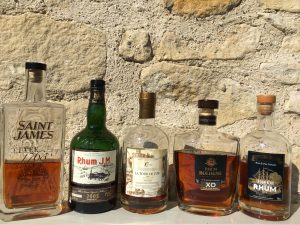
For our part, we classify the aromas of rum into 6 categories. But obviously this is not official and everyone can form their own opinion with experience.
“Empyreumatic” aromas
This word comes from ancient Greek and means fire, heat, embers: caramel , chocolate , mocha , roasted coffee or cocoa , burnt , leather , oil , smoke , tar (we think of Caroni), toast , peat , burnt wood ...
Spices
First, sweet : vanilla of course, which is found very frequently and in particular in traditional Spanish rums, but not only, gingerbread...
…and stronger: cinnamon , cloves , ginger , nutmeg , pepper …
The fruits
tropical fruits (ripe banana typical of the Jamaican Worthy Park distillery, coconut from the Foursquare distillery), from the orchard , red , cooked (quince jam from the Mauritian New Grove), dried ...
Plants
Wood of course, which is found in many old rums and which can be declined in many variations (dry wood, wet, burnt, Honduran cedar…), hay , cereals , dried cane leaf , freshly cut grass , medicinal aroma, menthol , liquorice , scent of undergrowth , mushroom , tea , tobacco …
The flowers
Jasmine , violet , immortelle …
and the “unclassifiable”!
…because we must not remain “locked” in concepts. To taste well, we must, on the contrary, open our mind and memory to experienced sensations:
• vegetable (taste the magnificent Paranubes from Mexico and you will have candied peppers and cooked tomatoes)
• iodized aroma (with a salty side very present in many agricultural white rums)
• and also for example: plastic , Roquefort (these last 2 categories are often the result of defects in the distillation process that are even seen in some major brands), mineral aroma , molasses , vesou wine (cane juice fermented before distillation), metal , animal aroma (quite rare for rum, much more common for whisky), solvent (very common in Jamaican rums)…
To help you choose your rums based on the aromas you are looking for, we have provided the main markers of most of the rums in our cellar (those for which we have produced the tasting note). Simply click on “profile” in the filter at the top of the screen.
Conservation
Once bottled, rum no longer ages . This great principle is however to be qualified because if we do not speak of real aging, we cannot however neglect the evolution that rum can undergo in the bottle.
Depending on storage conditions , rum can evaporate, oxidize, or completely collapse if left unattended.
First, it is very important to keep the bottle upright , so that the alcohol does not attack the cork. On the other hand, it is recommended to lay the bottle down for a few dozen minutes before opening an old bottle, in order to rehydrate the cork and avoid breakage when opening.
Then, oxidation can be the best or worst enemy of rum. Its contact with oxygen and the fact that it takes air in the bottle can allow it to open its aromatic palette and get rid of a side that is too raw. But if the contact between the air and the rum is too great or too long, the latter can lose all its power or see its aromas considerably tarnished.
To do this, calmly appreciate the evolution of the rum in the bottle , first up to the first third, up to half, then as you approach the last third. Beyond this limit, it is better to either:
– don’t delay too long and finish it in the following weeks (again, this can be beneficial, but the opposite risk is greater)
– re-bottle the rum in a smaller bottle
– borrow your children ’s glass marbles (previously sterilized) to fill the void in the bottle
– place the remaining few centilitres in sample bottles , to prepare for your future tastings with friends.
To go further
If you've already gone through all these tips and have tasted your entire cellar as well as that of your friends, far and wide, don't hesitate to try other spirits . You'll see that sometimes the line is fine with certain other families like whisky or cognac .
The more you smell and taste new things, the larger your aroma library will be, and the richer your reference points will be . But it doesn't stop at spirits, we encourage you to put your nose everywhere, create new references and rediscover your memories.
By reading our articles on rum making, then on cane, fermentation and aging, you will learn what primary, secondary and tertiary aromas are. Try to recognize which category the aromas you find in your rums fall into in order to understand what makes you like or dislike a certain character in a rum. You will understand that you prefer a certain type of cask or a particular distillation method, this will greatly help you in choosing your future purchases.
Try blind tasting , without taking into account the prestige, origin, price or age of the rums. You are never safe from a good surprise, and this allows you to break down stereotypes and question your preferences.
Nico from the Rhum Attitude team
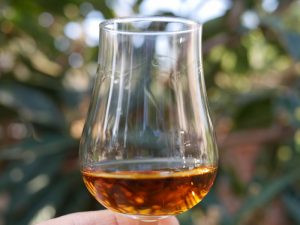
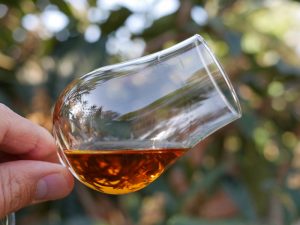

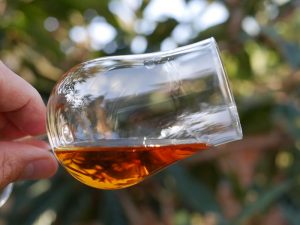

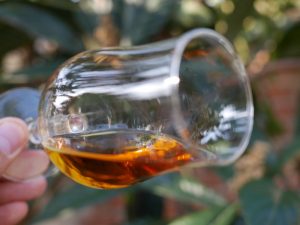


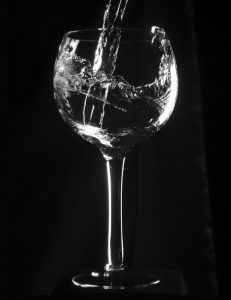



Good morning,
Should we understand that old rum is not valued in ti punch? The question is not addressed.
Hello Jacques, indeed the question is not addressed because the “ti'vieux” is a practice that certainly exists, but in a rather marginal way. However, indeed, a ti'punch with a “young” old rum (VO – 3 years) can be a pleasant experience. You just have to be careful to adapt the sugar to the degree, which is most of the time lower than for white rums. You can also replace the sugar with honey, which goes very well with the aromas of old rum.
Good morning,
As a recent subscriber to a tasting box every month, I would like to know, as mentioned in your article, whether transferring a rum into a smaller container does not harm it. Indeed, the bottle is opened and then emptied into several vials.
Thank you for your answers and for the rums that you allow subscribers or others to taste.
Hello Cyrille and thank you for your comment 🙂 no problem when you transfer the spirit into a smaller container. I would even say that it does it good when it is done just after opening the bottle (for sharing samples for example, as we do for the site) because it gives it a micro oxygenation, which allows to remove the lightest alcohols.
For my part, I transfer my rums into a 25cl bottle when it reaches the last third and I do not intend to finish it right away. It is not systematic, but sometimes when the volume of air is too important in the bottle, we lose a lot of power and the oxidation can be too strong.